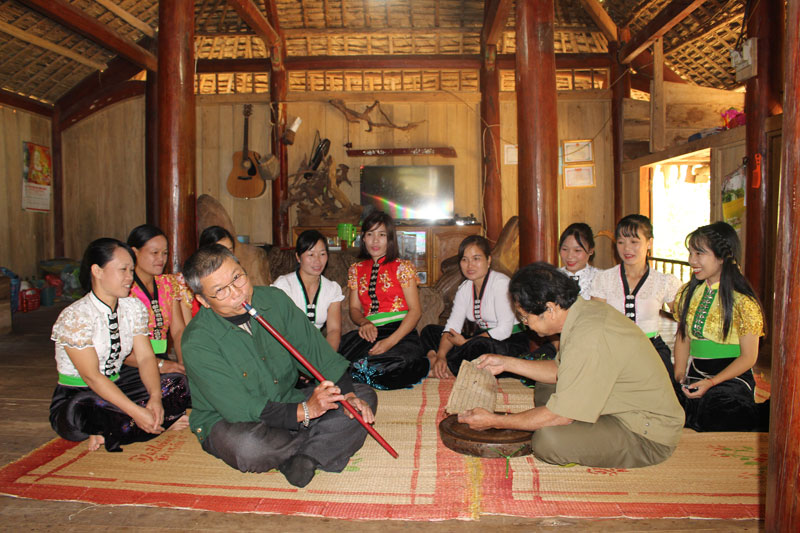
(HBO) - In the folk instrumental system of the Tay ethnic people, it is indispensable for Oi flute. The vibration of the Oi flute signals the sacred moment of heaven and earth, the transfer between the old and the new year. The melodious and passionate vibration of flute of the boys with their partners ... Every time when the flute vibrates, the old and the young, boys and girls, who are hand in hand, resound singing all over the area of Tay overnight and day.

Oi flute, an important instrument, is an indispensable
instrument to accompany Tay songs of Tay ethnic people in Da Bac.
The musical notes have a radius fitting the son's finger so
that he can flexibly use his fingers on the notes. To have the aesthetic the
flute is painted blue or red. Tay ethnic people hang the flute on the kitchen
counter to catch fire for the flute, making the sound of the flute as well as
educating the younger generation to preserve and conserve the art of playing Oi
flute in the community.
Oi flute is the main instrument, which is indispensable to
accompany the songs throughout the area of Tay. However, Oi flute is only used
during happy days, holidays, New Year, the sacred time transferring between the
old and the new year. In particular, Oi flute is the sound calling the mates of
the boys. In the tradition of Tay ethnic people, only boys are allowed to use
Oi flute, girls are absolutely not allowed.
Today, there are many electronic musical instruments in
modern life, but for Tay ethnic people, Oi flute still has a strong vitality. The
artisans and the seniors have been preserving and teaching how to make Oi flute
and how to use this kind of instrument for the young generation. The deep and
passionate melodies from this traditional instrument have been conveying the
message of love and happiness to the young generation.
Recently, the Party Committee and authorities of Da Bac
district have always paid attention to the preservation and promotion of the
national cultural identity. For Tay ethnic, Oi flute is an important instrument
which is indispensable, however, the number of Tay ethnic people being able to
use this instrument is not much. Therefore, the district regularly organizes
mass competitions and art performances so that the artisans and the elderly
people have the opportunity to perform Oi flute to the local people. In
addition, with the desire that friends from inside and outside the province can
enjoy the art of Oi flute, the district has invited the artisans to perform the
art of Oi flute at the major cultural events of the province.
With an increasingly vibrant and widespread emulation movement aimed at building cultured residential areas and cultured families, Yen Thuy District has been making steady progress toward improving both the material and spiritual well-being of its people, while fostering a civilized, prosperous, beautiful, and progressive community.
Once lacking recreational spaces and community facilities, Residential Group 2 in Quynh Lam Ward (Hoa Binh City) has recently received attention for the construction of a new, spacious, and fully equipped cultural house. The project followed the model of state support combined with public contributions in both labor and funding.
The "All people unite to build cultural life" movement, which has been effectively integrated with Kim Boi district’s socio-economic development goals, is fostering a lively spirit of emulation across local residential areas, hamlets, villages, public agencies, and enterprises. In addition, through the initiative, traditional cultural values are being preserved and promoted, while community solidarity and mutual support in poverty reduction and economic development are being strengthened.
A working delegation of the Hoa Binh provincial People’s Committee led by its Permanent Vice Chairman Nguyen Van Toan on June 11 inspected the progress of a project to build the Mo Muong Cultural Heritage Conservation Space linked to tourism services in Hop Phong commune, Cao Phong district.
Born and growing in the heroic land of Muong Dong, Dinh Thi Kieu Dung, a resident in Bo town of Kim Boi district, in her childhood was nurtured by the sweet lullabies of her grandmother and mother. These melodies deeply imprinted on her soul, becoming an inseparable part of her love for her ethnic group's culture. For over 20 years, this love for her hometown has driven Dung to research, collect, and pass down the cultural values of the Muong people to future generations.
In the final days of May, the Ethnic Art Troupe of Hoa Binh Province organized performances to serve the people in remote, mountainous, and particularly disadvantaged areas within the province. These were not just ordinary artistic shows, but they were the meaningful journeys aimed at spreading cultural values, enhancing the spiritual life of the people and contributing to the preservation of ethnic minority cultural identities.



